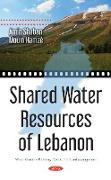Shared Water Resources of Lebanon
BücherAngebote / Angebote:
Water resources in the Middle East are barely enough to cope with human demand, and their scarcity is a matter of discussion in many conclaves. However, it must be clarified that Lebanon has a rugged topography that sets it apart from the surrounding regions. Its small area of 10, 452 km2 is characterised by a mountainous terrain marked by several valley systems. Two mountain chains (Mount Lebanon to the west and Anti-Lebanon to the east) extend parallel to the Mediterranean Sea, and are separated by the Bekaa Plain, which comprises a relatively wide depression. Hence, Lebanon has many sources of surface water including rivers, springs, snowfalls and lakes, besides, many aquiferous rock formations and karstic conduits exist where groundwater can accumulate via seeping. However, complaints concerning the lack of understanding about the imbalanced water supply/demand in Lebanon are often a matter of debate, and the water budget is also not well-formulated yet. Added to the matter of water shortage and deterioration in quality thereof, challenges for water resources have only exacerbated. Thus, there are parallel paths stemming from both natural and human driving forces leading to increasing water stress. Climate change, pollution, over-exploitation and the mismanagement of trans-boundary water resources are amongst the geo-environmental problems that affect these resources. In particular, shared water is one of the major water problems in Lebanon. To put this issue into perspective, more than 74% of Lebanons border is shared with neighbouring countries, which makes the surface and groundwater intermingle with neighbouring regions, thus, no volumetric measures are known. Two shared rivers exist between Lebanon and its neighbours: one with Syria in the north, and the other with the Palestinian Territory (PT) in the south. In addition, the three major aquiferous rock formations of Lebanon are interrelated with neighbouring regions. To date, there is no credible study to assess and allocate the shared water resources. Consequently, geo-political conflicts frequently arise due to the obscure nature of the hydrologic conditions. In addition, the absence of treaties and agreements is another reason affecting water sharing, which constitutes the principal cause of water loss. This is totally governed by the unstable political situation in the region. This book aims to highlight the principles of Lebanons water resources with new numeric measures. It will also reveal the major elements of the striking challenges. Thus, the fundamental hydrologic aspects of shared water resources in Lebanon, including quantitative measures and the spatial extent of these resources will be illustrated.
Folgt in ca. 10 Arbeitstagen
